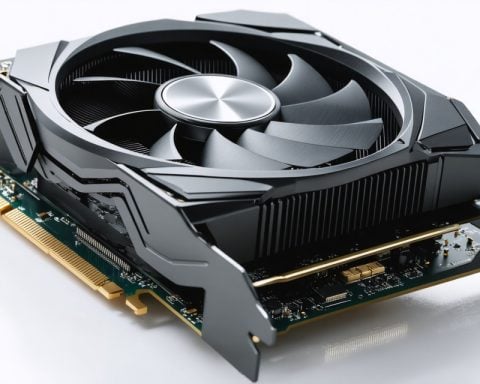- Soundhound AI stocks experienced extreme fluctuations, peaking at an 883% increase but later dropping by 55%.
- The Federal Reserve’s hints at fewer interest rate cuts adversely affected high-growth stocks like Soundhound AI.
- Nvidia’s strategic exit from its investment in Soundhound AI triggered investor concern but may not reflect Soundhound’s potential.
- Soundhound AI posted record revenues last quarter, increasing by 89% year-over-year, indicating growth despite challenges.
- The company targets diverse sectors and a $140 billion voice AI market, indicating untapped potential despite profitability concerns.
- Soundhound AI’s lofty valuation suggests a risky investment, but its strategic pivots could offer a lucrative opportunity for daring investors.
- Nvidia’s exit may ultimately benefit Soundhound AI as it explores broader market ambitions and innovation.
In a world fueled by artificial intelligence, stocks of companies like Soundhound AI have ridden tumultuous waves. Last year, the company’s shares rocked skyward by a staggering 883%. Yet, in a dramatic shift, they’ve since dipped by 55%, prompting investors to question its future.
Recent maneuvers by the Federal Reserve hinted at fewer interest rate cuts, rattling high-growth stocks, including Soundhound AI. But a different storm brewed when tech titan Nvidia made a strategic exit from its investment in Soundhound, previously seen as a golden endorsement.
The revelation hit like a thunderclap. Nvidia, once a supportive investor since 2017, disclosed a complete divestment from Soundhound AI, triggering a sell-off. For some, Nvidia’s departure sounded an alarm, yet the move might not signal what it seems. Nvidia could have myriad reasons — strategic reshuffling among them — unrelated to Soundhound’s capabilities.
Despite the turbulent market, Soundhound continues to lay a promising path. Last quarter, it posted record revenues, surging by 89% from the previous year. Its business model now spans diverse sectors, including automotive, finance, and healthcare, demonstrating untapped potential in the $140 billion voice AI market.
True, Soundhound AI grapples with profitability and fierce competition. Its lofty valuation still hovers at nearly 50 times sales, posing a risky bet. Yet, the company is charting its course towards innovation and growth.
For risk-takers willing to brave volatility, the recent dip could be a gateway to opportunity. With Soundhound’s strategic pivots and broader market ambitions, Nvidia’s exit could prove to be a blessing in disguise. The company’s journey isn’t for the faint-hearted, but for those with vision, it may very well be worth the ride.
The Rise, Fall, and Future of Soundhound AI: What Investors Need to Know
How-To Steps & Life Hacks: Navigating Investments in AI Stocks
1. Diversify Your Portfolio: AI stocks, including Soundhound AI, can be volatile. Ensure your portfolio includes a mix of established, stable industries alongside high-growth opportunities.
2. Stay Informed on Market Trends: Monitor Federal Reserve announcements and macroeconomic indicators as they can affect high-growth stocks like those in the AI sector.
3. Analyze Strategic Partnerships: Keep an eye on key partnerships and endorsements, like Nvidia’s previous support for Soundhound, as these can significantly impact company valuation and market perception.
Real-World Use Cases: Soundhound AI’s Applications
Soundhound AI’s capabilities extend across various sectors:
– Automotive: Enhancing the in-car experience with voice-activated controls and infotainment systems.
– Finance: Revolutionizing customer service with AI-driven chatbots and voice banking.
– Healthcare: Improving patient interaction and administrative efficiency with voice-enabled technologies.
Market Forecasts & Industry Trends
The voice AI market is projected to reach $140 billion, with a compound annual growth rate (CAGR) of over 30% in the coming years. Soundhound AI is strategically positioned to tap into this growth, leveraging its expertise in natural language processing and voice recognition.
Reviews & Comparisons
Compared to competitors like Google Assistant and Amazon Alexa, Soundhound AI focuses on a platform-agnostic approach, allowing greater flexibility and integration across different hardware and software systems.
Controversies & Limitations
Despite its strengths, Soundhound AI faces challenges:
– Profitability Concerns: Like many high-growth tech companies, consistent profitability remains elusive.
– High Valuation: At nearly 50 times sales, the valuation presents a risk, especially when market sentiment shifts.
Features, Specs & Pricing
Soundhound AI’s platform offers:
– Advanced Voice Recognition: Accurate in noisy environments and different languages.
– Customizable Solutions: Tailored to industry-specific needs, enhancing utility and adoption.
Security & Sustainability
Soundhound AI is committed to data security and privacy, crucial for sectors like finance and healthcare. They adhere to compliance standards to ensure user data is protected.
Insights & Predictions
– Strategic Growth: Continued expansion into untapped markets shows promise.
– Innovation Focus: Developing cutting-edge AI technology will likely enhance their competitive advantage.
Tutorials & Compatibility
Soundhound AI offers developer-friendly tools for integration across multiple devices and platforms, facilitating easier adoption and application development.
Pros & Cons Overview
Pros:
– Strong revenue growth.
– Diverse sector applications.
– Robust technological backbone.
Cons:
– Market volatility.
– High valuation risk.
– Profitability challenges.
Actionable Recommendations
Investors should conduct due diligence by analyzing financial health, market position, and strategic initiatives of Soundhound AI. Monitor economic indicators and tech sector movements for informed decision-making.
For more insights, explore the financial world at Reuters or delve into technological advancements at TechCrunch.






















